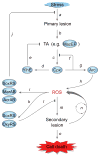Reactive oxygen species and the bacterial response to lethal stress
- PMID: 25078317
- PMCID: PMC4254325
- DOI: 10.1016/j.mib.2014.06.008
Reactive oxygen species and the bacterial response to lethal stress
Abstract
Bacteria are killed by a variety of lethal stressors, some of which promote a cascade of reactive oxygen species (ROS). Perturbations expected to alter ROS accumulation affect the lethal action of diverse antibacterials, leading to the hypothesis that killing by these agents can involve ROS-mediated self-destruction. Recent challenges to the hypothesis are considered, particularly with respect to complexities in assays that distinguish primary damage from the cellular response to that damage. Also considered are bifunctional factors that are protective at low stress levels but destructive at high levels. These considerations, plus new data, support an involvement of ROS in the lethal action of some antimicrobials and raise important questions concerning consumption of antioxidant dietary supplements during antimicrobial chemotherapy.
Copyright © 2014 Elsevier Ltd. All rights reserved.
Figures

Similar articles
-
Bacterial death from treatment with fluoroquinolones and other lethal stressors.Expert Rev Anti Infect Ther. 2021 May;19(5):601-618. doi: 10.1080/14787210.2021.1840353. Epub 2020 Nov 16. Expert Rev Anti Infect Ther. 2021. PMID: 33081547 Review.
-
Post-stress bacterial cell death mediated by reactive oxygen species.Proc Natl Acad Sci U S A. 2019 May 14;116(20):10064-10071. doi: 10.1073/pnas.1901730116. Epub 2019 Apr 4. Proc Natl Acad Sci U S A. 2019. PMID: 30948634 Free PMC article.
-
Moving forward with reactive oxygen species involvement in antimicrobial lethality.J Antimicrob Chemother. 2015 Mar;70(3):639-42. doi: 10.1093/jac/dku463. Epub 2014 Nov 23. J Antimicrob Chemother. 2015. PMID: 25422287 Free PMC article. Review.
-
Ribosomal elongation factor 4 promotes cell death associated with lethal stress.mBio. 2014 Dec 9;5(6):e01708. doi: 10.1128/mBio.01708-14. mBio. 2014. PMID: 25491353 Free PMC article.
-
One size does not fit all--bacterial cell death by antibiotics cannot be explained by the action of reactive oxygen species.Angew Chem Int Ed Engl. 2013 Oct 11;52(42):10946-8. doi: 10.1002/anie.201304548. Epub 2013 Sep 3. Angew Chem Int Ed Engl. 2013. PMID: 24038937
Cited by
-
Dimethyl Sulfoxide Protects Escherichia coli from Rapid Antimicrobial-Mediated Killing.Antimicrob Agents Chemother. 2016 Jul 22;60(8):5054-8. doi: 10.1128/AAC.03003-15. Print 2016 Aug. Antimicrob Agents Chemother. 2016. PMID: 27246776 Free PMC article.
-
Metabolomics analysis of the lactobacillus plantarum ATCC 14917 response to antibiotic stress.BMC Microbiol. 2024 Jun 28;24(1):229. doi: 10.1186/s12866-024-03385-3. BMC Microbiol. 2024. PMID: 38943061 Free PMC article.
-
A broadly applicable, stress-mediated bacterial death pathway regulated by the phosphotransferase system (PTS) and the cAMP-Crp cascade.Proc Natl Acad Sci U S A. 2022 Jun 7;119(23):e2118566119. doi: 10.1073/pnas.2118566119. Epub 2022 Jun 1. Proc Natl Acad Sci U S A. 2022. PMID: 35648826 Free PMC article.
-
Bacterial toxicity of biomimetic green zinc oxide nanoantibiotic: insights into ZnONP uptake and nanocolloid-bacteria interface.Toxicol Res (Camb). 2018 Dec 26;8(2):246-261. doi: 10.1039/c8tx00267c. eCollection 2019 Mar 1. Toxicol Res (Camb). 2018. PMID: 30997024 Free PMC article.
-
Metalloregulation of Helicobacter pylori physiology and pathogenesis.Front Microbiol. 2015 Sep 2;6:911. doi: 10.3389/fmicb.2015.00911. eCollection 2015. Front Microbiol. 2015. PMID: 26388855 Free PMC article. Review.
References
-
- Imlay JA. Pathways of oxidative damage. Annu Rev Microbiol. 2003;57:395–418. - PubMed
Publication types
MeSH terms
Substances
Grants and funding
LinkOut - more resources
Full Text Sources
Other Literature Sources
Medical

